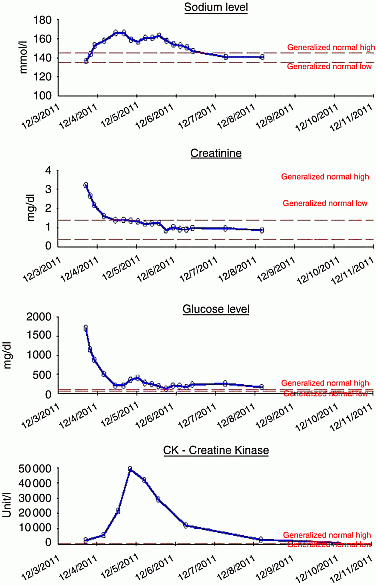ICEECE2012 Poster Presentations Clinical case reports - Thyroid/Others (81 abstracts)
New diabetic emergency; acute rhabdomyolysis complicating hyperglycemic hyperosmolar coma successful management and insight into pathogenesis
C. Vaz & A. Chaudhuri
1State University of New York, Buffalo, New York, USA.
We describe a case of severe rhabdomyolysis(peak CK 48897 μ/ml and massive myoglobinuria) complicating hyperglycemic hyperosmolar coma. A 57y/o M with DM2 on metformin presented with polyuria, polydipsia, weakness and confusion. On admission he had GCS E2M3V1 no signs of trauma or infection. Na 137 mEq/l K 4.8 mEq/l HCO3 22 mEq/l Cl 93 mEq/l BUN 116 mg/dl Cr 3.2 mg/dl glucose 1710 mg/dl pH 7.22 ketones +small, Mg 5.2 mg/dl P 3.3 mg/dl Ca 9.6 mg/dl TSH 1.47 μU/ml Ethanol <5 mg/dl, toxicology screen negative, osmolality 364 mOsm/kg. Initial Troponin 0.03 ng/ml, peak 0.12 ng/ml 28 h later. Initial CK 2379 μ/l, 21767 μ/l at 24 h, peak 48 897 μ/l 28 h later. CK isoenzyme 100%MM. Urine myoglobin >10 000 ng/ml (nl<1). As he was on flexeril, serum and urine cyclobenzaprine level were checked and were negative. He received aggressive i.v. hydration with NS and Bicarb drip along with insulin drip. Blood glucose control was achieved over 48 h. Cr normalized in 28 h. Na peaked to 166 mg/dl and corrected over 3 days. P and K levels remained nl. CK trended down to 881 μ/l on day 7. Mental status was at baseline by day 3. Hyperglycemic hyperosmolar state precipitates rhabdomyolysis which aggravates acute renal failure. Pathogenesis of this nontraumatic rhabdomyolysis is multifactorial including, inhibition of the Na pump by hyperosmolar state, acidosis, hypernatremia, K deficiency, decrease in intramuscular energy supply from insulin deficiency1. Resultant fall in transmembrane potential and elevated intracellular Ca, activates proteases with leakage of muscle enzymes resulting in rhabdomyolysis2. We also hypothesize that the prothrombotic state induced by severe hyperglycemia causes muscle tissue infarction and elevated CK, confirmed in our case as 100% MM. Prompt recognition and treatment with bicarb drip as in our case can avert acute renal failure precipitated by this unusual cause of rhabdomyolysis. CK is not routinely measured in hyperosmolar hyperglycemic states. We recommend routine monitoring of CK in these cases with particular attention to cases with very high Na as without early recognition and treatment of rhabdomyolysis, patients could have potentially fatal outcomes. We suggest CK be remeasured a day after peak glucose and serum osmolality given the temporal association demonstrated by our case.
1. Am J Nephrol 11 447–450.
2. Nephron 47 202–204.

Declaration of interest: The authors declare that there is no conflict of interest that could be perceived as prejudicing the impartiality of the research project.
Funding: This research did not receive any specific grant from any funding agency in the public, commercial or not-for-profit sector.




